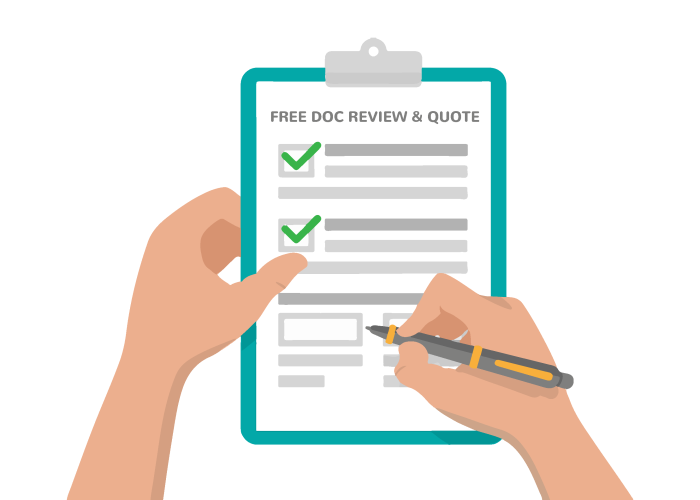Essential Parts of a Compliant PDF Document
Digital accessibility is the concept of making sure every person can access and use information provided in digital formats. A digitally accessible PDF document has content that can be read by any person, no matter how they are accessing the document. Many people use assistive technology such as screen readers and connected Braille displays to access PDFs and other digital information. Many of these people do not use a mouse. Instead, they rely on the keyboard (or other means) to navigate their screen.
All documents need to contain digital “tags” (a type of digital label) for assistive technology users to fully access it. These tags explain to the user how the information in the document is organized. In some cases, the tags explain exactly what the information is. Assistive technology understands these tags, but they won’t be visually evident to a user who doesn’t use assistive technology. The PDF document will appear unchanged for a sighted user.
Accessible PDFs contain Headings
Headings work just like newspaper headlines. They announce the content that follows. This allows users to navigate a document to find information they need without having to read every single word. If a person wants to know what desserts a restaurant has to offer, they don’t read the entire online menu. They skim the menu using the headings until they reach the “Dessert” section of the menu. Visually, headings will usually be a larger size, heavier weight, and a different font than the rest of the text. A digital tag is required for a person who doesn’t see the content but accesses it using assistive technology, to understand which parts are the headings.
Accessible PDFs Provide Alt-Text for Images
Images cannot be “seen” by assistive technology. Screen readers and Braille displays can identify an element of a PDF document as an image or graphic, but not what it depicts. In order to convey the information intended by an image or graphic, an alternative text (or, “alt-text”) must be provided. Alt-text is a brief, clear description of what the image or graphic shows. It provides pertinent information about the image and its context. If it’s a logo, something as simple as “Bob’s company logo” will suffice. If the image is of a chart, graph, or diagram, more detail will be needed. Assistive technology users miss information that other users would have if no alt text is included.
Accessible PDFs have Descriptive Links
It is important that any links within a PDF document describe the location to which they lead. None of us likes to see a link such as https://www.getremdoc.com/blog/ada-compliance-for-documents/ when ADA Compliance for Documents more clearly tells the reader where the link is going. Links should be embedded in descriptive text so that everyone understands where the link is taking them. This is best practice for all readers, but especially for someone using assistive technology.
Further, for an assistive technology user to be able to actually visit the link, an actionable digital link tag is required. Without a tag, a link might be functional for someone using a mouse to click on it but not for someone using only the keyboard.
Accessible PDFs use Tagged Reading Order
Reading order is just what it says: the order in which the content is read. For many documents, a top-to-bottom, left-to-right order of the content is correct. The document reads starting at the top of the page and proceeding across and down. However, not every document is organized that way.
For assistive technology understands the reading order by the order in which the digital tags are presented. That may not be the same as they appear visually. Including items like images, charts, tables, or lists can interrupt text and skew reading order. Documents containing columns of text, rather than simple left to right text across the page, need to be correctly tagged. The tags instruct assistive technology to read the paragraphs correctly, column 1 first, then column 2, and so on.
Sometimes when an element was added to the document determines the reading order. Adding an element (such as an additional paragraph, or some headings) partway through the creation process of a document means that element may not be read digitally in the correct order. Always check digital tag order. This ensures that a paragraph inserted at the beginning of the document isn’t read last because it was the last item added.
Accessible PDFs have Tagged Lists
Lists are an element that we might not think of as requiring different digital tags than regular text. Visually, it’s easy to see when content is in a list format. However, text that is in list format reads for assistive technology simply as a barrage of words unless it is digitally tagged as a list. A grocery list will be read as “milk bread eggs flour sugar chicken” without any explanation that the words are related and part of a unit. Additionally, a list that has nested items will make even less sense if there are no digital tags explaining it:
- Fruit
- Bananas
- Apples
- Granny Smith
- Honeycrisp
- Vegetables
- Carrots
- Potatoes
- Russet
- Yukon Gold
Without correct tagging, this list will read “fruit bananas apples Granny Smith Honeycrisp vegetables carrots potatoes russet Yukon gold broccoli.” It will not differentiate that “fruit” and “vegetables” are parent-level list items for bananas, apples, carrots, etc., nor will it explain that Granny Smith and Honeycrisp are types of apples while Russet and Yukon Gold are types of potatoes. To fully understand what is meant to be conveyed by the list and its formatting, that information is necessary. So each list item and its “child” items need to be correctly tagged so that assistive technology can pass that information on to the user.
Accessible PDFs include Tagged Tables
Just like lists, tables are a confusing barrage of information for an assistive technology user unless the proper digital tags are included. Each row and column must be tagged, and each individual cell in the table must be tagged so that the user can understand which rows and columns to which it relates. Any row and column headings must be tagged as headings, and any merged cells need to be digitally tagged to avoid confusion. It can be quite complicated to properly tag a table so that assistive technology users can make use of the content. Even simple tables contain many digital tags to help the user follow the intent of the table’s formatting and content. There should also be a digital table summary that explains the contents and any irregularities. It should tell the user how many header rows and columns there are, and identify any merged cells.
PDFs Require Remediation to be Accessible
Most PDF documents are created in one file format type and then saved as a PDF to preserve the formatting and visual look of the document. That is the strength of a PDF (portable document files) – it is secure and will retain its formatting and look visually the same no matter how the user accesses the document. Some document creation software produce a fairly accessible document that automatically contains digital tags without much effort. For example, most documents in MS Word are very accessible and often only require the addition of alt-text and heading tags. Others are less accessible “out of the box.” Once converted into PDF format, nearly all require remediation (the addition and verification of digital tags) before they can be considered accessible.
Remediation does not have to be difficult but it can take some time. Having the correct tools can dramatically reduce the time necessary to apply the digital tags required to make a document accessible and usable for everyone. Alternatively, you can outsource the project and allow professionals to remediate the documents reducing time and money.
Learn more about RemDoc’s PDF Remediation Services and get your documents reviewed below.





